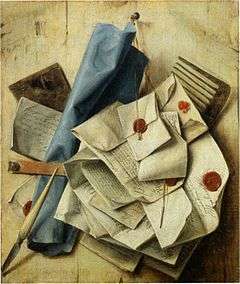Sigillography
Sigillography, also known by its Greek-derived name, sphragistics, is the scholarly discipline that studies the wax, lead, clay, and other seals used to authenticate archival documents. It investigates not only aspects of the artistic design and production of seals (both matrices and impressions), but also considers the legal, administrative and social contexts in which they were used. It has links to diplomatics, heraldry, social history, and the history of art, and is regarded as one of the auxiliary sciences of history.
.png)

Etymology
The word sigillography derives from the Latin word sigillum, meaning "seal", and the Greek suffix γραφή, meaning "description". It was effectively coined (as the Italian word, sigillografia) by Anton Stefano Cartari in 1682.[1] The alternative term, sphragistics, is derived from the Greek word σϕρᾱγίς, meaning "seal".
History
Antiquaries such as Thomas Elmham and John Rous began to record and to discuss the historic use of seals in the 15th century. In the 16th and 17th centuries the consideration of seals became a fairly widespread antiquarian activity. Notable early students and collectors included Robert Glover, John Dee, Sir Robert Cotton and Nicolas-Claude de Peiresc.[2][3][4][5]
The first published treatises dedicated to seals included Giorgio Longo's De anulis signatoriis antiquorum (Milan, 1615); Olivier de Wree's Sigilla comitum Flandriae (Bruges, 1639); and Theodorus Hoepingk's De sigillorum prisco et novo jure tractatus (Nuremberg, 1642). Especially influential in shaping the discipline were Jean Mabillon's De re diplomatica (1681) and Johann Michael Heineccius' De veteribus Germanorum aliarumque nationum sigillis (1710). In the second half of the 19th century sigillography was further developed by German scholars including Hermann Grotefend and Otto Posse, and French scholars including Louis Douët d'Arcq and Germain Demay.
Sigillography is also an important subdiscipline of Byzantine studies, involving the study of Byzantine lead seal impressions and the text and images thereon. Its importance derives from both the scarcity of surviving Byzantine documents themselves, and from the large number (over 40,000) of extant seals.[6] One of the largest compendiums of Byzantine seals can be found in the large volume by Gustave Schlumberger, Sigillographie de l'empire Byzantin, published in 1904.[7]
Popular culture
Sigillography features in the plot of King Ottokar's Sceptre (1939/1947), one of The Adventures of Tintin. Tintin accompanies Professor Alembick, a sigillographer, on a research trip to the Balkan nation of Syldavia, only to become embroiled in a plot to dethrone the King.
References
- Sandri, Leopoldo (1955). "La 'Sigillografia Universale' di Anton Stefano Cartari: contributo agli studi di sigillografia nel sec. XVII". Rassegna degli Archivi di Stato. 15: 141–88.
- Harris, Oliver D. (2019). "Fragments of the past: the early antiquarian perception and study of seals in England". In Whatley, Laura (ed.). A Companion to Seals in the Middle Ages. Leiden: Brill. pp. 129–54. ISBN 978-90-04-38064-6.
- Harvey, P. D. A.; McGuinness, Andrew (1996). A Guide to British Medieval Seals. London: British Library and Public Record Office. pp. 22–26. ISBN 0-7123-0410-X.
- New, Elizabeth (2010). Seals and Sealing Practices. Archives and the User. 11. London: British Records Association. pp. 29–32. ISBN 978-0-900222-15-3.
- Bascapé, Giacomo C. (1969). "Storia della sigillografia". In Bascapé, Giacomo C.; Welber, Mariano (eds.). Sigillografia: il sigillo nella diplomatica, nel diritto, nella storia, nell'arte. 1. (Milan: Antonino Giuffré. pp. 35–51.
- Kazhdan, Alexander, ed. (1991). Oxford Dictionary of Byzantium. Oxford University Press. pp. 1894–1895. ISBN 978-0-19-504652-6.
- Schlumberger, Gustave, ed. (1904). Sigillographie de l'empire Byzantin. Ernest Leroux.
| Look up sigillography or sphragistics in Wiktionary, the free dictionary. |